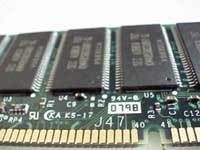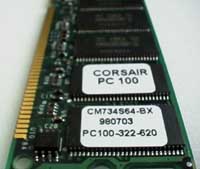Ok, its great that we know what the PC100 Specification includes, however what does that matter if we have no idea why in the world specifications for trace width and spacing must be precise, and what placing series termination resistors on the data lines allows us to do? So let's filter out some of the garbage and come up with a "translated" version of the PC100 specification.
One of the biggest problems with the generic SDRAM modules you can go out to just about any vendor and pick up was that their modules, while they could be using high quality NEC chips, were built on low quality Printed Circuit Boards (PCB's). Think of it as putting a Ford engine in a Porsche frame, don't expect to get the same performance as if you used a genuine Porsche V-8, the same concept applies to SDRAM, although it is an obscure comparison it relates almost seamlessly. For the most part, generic SDRAM "sticks" as they are often called, used high quality chips from companies like NEC, Micron, Hitachi, or Samsung (SEC), however the PCB's were manufactured in a cost effective manner, in most cases rendering the SDRAM modules incapacitated when used in certain combinations. In order to cut costs some manufacturers chose to use 4-layer PCB's compared to the recommended 6 and 8-layer PCB's for SDRAM, as a result 4-layer boards were much susceptible to physical damage, and as you might guess a 4-layer board contains much less electrical insulation compared to 6 and 8-layer boards, this provides for increased levels of noise in the current. For this reason the PC100 specification clearly states that modules must be manufactured on 6-layer PCB's, and nothing less, so say good bye to those cheaper 4-layer boards. Some companies have already been manufacturing SDRAM using 6-layer PCB's, Advanced Megatrends for example has been manufacturing SDRAM using an 8-layer PCB for quite some time now, as a result their SDRAM is some of the most stable out today.
Try this little experiment, take a normally sharpened pencil, and using a straight edge draw a vertical line. Moving the straight edge a millimeter or so to the left draw another line parallel to the first one, now take a look at what you've done. You have two lines, however the lines aren't completely independent of one another, provided your pencil wasn't razor sharp the lines probably started to blend into each other somewhat in between the two.
| The same thing applies to SDRAM, the PC100 specification includes explicit details as to the width and spacing of trace lines (the lines printed on PCB's) in order to minimize the levels of cross talk (electrical interference, on the experiment above it would be the points where the two lines blended into each other) between traces adjacent or parallel to one another. The SDRAM modules out on the market today don't follow any set specification for trace length and width, some manufacturers chose to use specifications much like those described in the PC100 specification, while others are far from that. |  |
There are two more parts to the PC100 specification that must be mentioned in order to get the main idea of the purpose of the specification, the first is the Detailed SDRAM component specification. This basically states that a manufacturer MUST use PC100 compliant SDRAMs (the actual chips) in order for their modules, which also must meet the PC100 specification, in order for them to market their modules as PC100 compliant SDRAM. Currently just about every manufacturer claims that their SDRAM operates at 100MHz, however in reality a very small percentage of this SDRAM is even remotely stable at the 100MHz bus speed. Even the high quality Advanced Megatrends SDRAM mentioned above has problems at a true 100MHz bus speed (an actual 100MHz frequency, not 92MHz like the setting on the ABIT LX6). The chips used on PC100 compliant SDRAM modules will be manufactured using a special die and will have an access time of approximately 8ns.
Finally, the PC100 specification provides a detailed description of the timing parameters and data to be included on the onboard Serial Presence Detect (SPD) EEPROM located on ALL PC100 SDRAM modules. This SPD EEPROM is used to communicate with the BX chipset, and although it won't really make a difference with Aladdin V, MVP3, and SiS 5591 motherboards, it allows the BIOS and the Chipset to communicate with the memory to properly configure the memory timings to control the memory. Without a properly programmed EEPROM the BX chipset may misinterpret an instruction or the BIOS may "guess" as to how the SDRAM should be configured, in both cases resulting in unstable system operation.
| One small addition included in the PC100 specification is the requirement for a standard identification on all PC100 SDRAMs, the labels are required to have the format PC100-abc-def, where the 'abc-def' string would be replaced by 4 key timing parameters of the module and the revision number of the SPD specification. Uniformity...not bad. |  |
In order to test the Corsair PC100 64MB module at the 100MHz Bus Speed, the Tyan Titan Turbo ATX-2 motherboard was used which unofficially supports the 100MHz bus speed, while the SDRAM had no problem handling the overclocked bus speed, the L2 cache on board caused many problems which prevented any accurate test results from being achieved on the motherboard. The ABIT LX6, which also unofficially supports the 100MHz bus speed (in reality the bus frequency is closer to 92 or 94MHz) had no problems with the Corsair module, allowing me to set the BIOS memory timings to the fastest settings possible at all bus speeds, however this isn't a huge accomplishment since the Advanced Megatrends SDRAM I have been using for months was capable of doing the same. Until we see the first BX or Super7 motherboards that can properly operate at the 100MHz bus speed setting there is no real test for the PC100 SDRAM DIMMs, however it is safe to put your faith in these modules, if you're buying SDRAM in the near future, don't accept any substitutes.
According to Intel, SMART Modular Technologies PC100 SDRAMs will be used as the test bed for Intel CPUs and motherboards, whether or not this indication will hold true in the future is out of my hands to predict, but expect the equality between different SDRAM modules to grow tremendously once the PC100 specification has been out for a few months.
As a first look, there is not much we can tell about the compatibility of upcoming PC100 SDRAM DIMMs, however the current tests show that the DIMMs have no problems with even the most picky LX motherboards, older TX and VP2 boards don't seem to have any problems with the more expensive modules either. The bottom line is that if you're planning to buy SDRAM that will last you for some time, don't go after anything but modules that officially meet the PC100 specification.
Check out Corsair Microsystems for more information on the standard, and their PC100 SDRAM DIMMs.
New Frontiers Computers will carry the Corsair PC100 SDRAM DIMMs upon their public release.










0 Comments
View All Comments